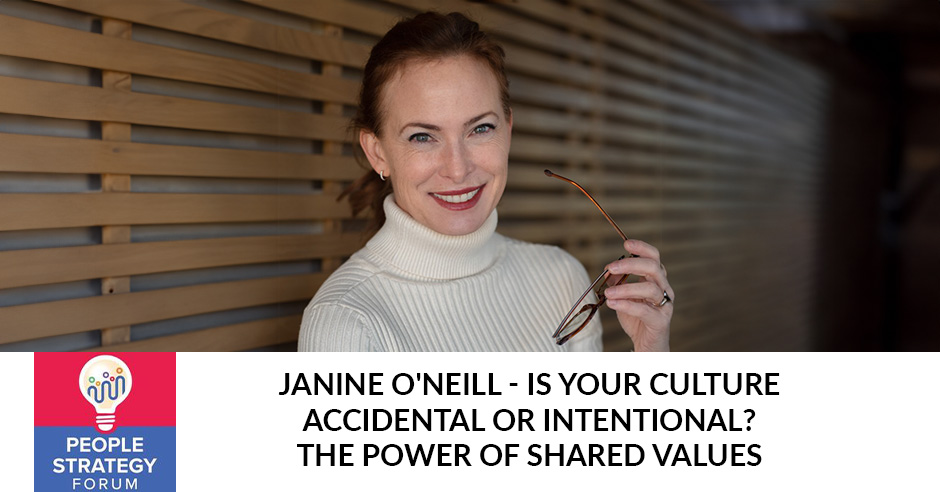Janine O’Neill – Is Your Culture Accidental Or Intentional? The Power Of Shared Values

Is your company culture a mere accident, or a carefully crafted reflection of your organization’s core values? In this episode, Janine O’Neill, co-founder of ElevenX Talent, discusses the importance of intentional culture in driving company success. With a rich background, Janine combines her expertise in talent acquisition and innovation to address how culture can either drive or hinder organizational success. She highlights the pivotal role of leadership in shaping and reinforcing company values, and provides practical advice for building and maintaining a strong culture, even in remote work environments. Tune in to learn practical strategies for aligning your company’s culture with your values and goals.
—
Janine O’Neill – Is Your Culture Accidental Or Intentional? The Power Of Shared Values
Introduction
Welcome to the show. We’re a show that guides leaders on how to elevate the workforce. We believe that people are at the heart of successful organizations. A team member’s well-being, rewards, and career development are all essential to a happy, healthy, and highly productive workforce environment. This show discusses the practical and effective leadership strategies for top executives, senior professionals, and talent managers overall.
First, I would like to introduce you to our host. Our host here that’s with us is Howard Nizewitz. Howard has been a seasoned HR and compensation advisor for the past 30 years. We’re very fortunate to have him here. Also, we have Char Miller. She is a strategy and skills consultant at the Strategic Thinking Institute. She’s also a talent management strategist and career and entrepreneur coach. She helps a lot of you out there who are thinking about becoming an entrepreneur and how to transform from the corporate world into the career consulting world. Also, she’s an expert at living in different places. She can help you make that transition effective.
In this episode, we explore the question, is your culture accidental or intentional? We’re thrilled to have with us Janine O’Neill, a Cofounder of ElevenX Talent. That’s a firm that is reshaping how startups build their executive teams. With over two decades in the talent industry, Janine brings a wealth of knowledge in talent acquisition, leadership development, and strategic coaching. Her experience is particularly rich with early-stage and growth-stage companies where she’s passionately committed to aligning innovative talent strategies with the broader business objectives to fuel sustainable growth.
Janine will dive into the intentional culture rooted in shared values that can dramatically transform your organization. Her insights will illuminate the critical path from simply hiring talent to building a cohesive, powerful team driven by common goals. Let’s learn how to craft a culture that is not just present by chance, but intentional by design. Welcome, Janine.
Thank you. This is so interesting and fun to have all of you talk about this topic that I’m very passionate about.
It’s going to be fun. The first thing I would love to do as we dive in here is to understand a little bit of your background. For the audience out there, Janine and I worked together years ago at Barclays and BlackRock before she launched into other areas in her career. Tell us a little bit about yourself, how you got into this particular niche, and how you help your clients.
I have been very fortunate that I started my career in recruiting. When you find something that is such a perfect match with how you operate in the world, extroverted, love talking to people, love understanding problems and situations, and love matchmaking, I feel like that was the beginning of what was an ideal career for me.
It evolved in various ways in getting to see a very strategic environment where exec search firms live, like Spencer Stuart of the SHREK firms, and then going in-house to a company like Barclays Global Investors, which was known for innovation among financial services firms and even among talent practices. That was very much at the forefront. I learned so much there and then cut my teeth doing HR, not just talent acquisition. I loved being in an innovative environment. Marrying both recruiting and innovation was starting to get my juices flowing.
I then went into the tech world at Sequoia Capital. I helped a lot of founders with their G&A and go-to-market, recruiting from early-stage companies to growth-stage companies. When I started this company, ElevenX Talent, in 2023, I focused on go-to-market. It was pulling all those threads forward to the present day and understanding some of the huge obstacles that exist for companies to scale. One I love to talk about is culture.
Intentional Vs. Accidental Culture
It’s a big piece. Employees and candidates out there are looking for more than a paycheck. Culture is a big driver of why people decide to work where they want to work. Can you tell us a little bit of what it means about being intentional about your culture versus accidental?
Culture exists whether you intend it or not. It’s the unwritten social order of the organization. Since it’s unwritten, the big gap is how you understand the unwritten and turn it into something written. Written means it’s intentional, and then you can make sure that the culture remains in the way that you want as you scale. The unwritten thing could be how we make decisions. Are we consensus-driven or is it top-down? It could be everything from whether we are direct communicators or more passive communicators.
Culture exists whether you intend it or not. It's the unwritten social order of the organization. Share on XThere are lots of ways that you can identify cultural tenets and then the underlying values that drive them. There are a lot of examples of great cultures. At least we know those cultures because the companies are so successful and scaled so well. Amazon has sixteen principles that they follow. We know that it started with customer obsession and that it led to a tremendously successful global company. Those things were written down, and those things helped everybody who joined Amazon know what the North Stars were. Culture can be a reason that people go to a company and a reason that people leave regardless of whether it’s codified in writing or the social order that exists.
Can you tell us a situation when you walked into a client to help them out and you didn’t see that writing on the wall or you didn’t see a well-communicated, intentional culture? What are the things that you would recommend to transform their approach to be more effective?
A lot of people leaders are in this spot where they are charged with codifying a culture. If they don’t get alignment with the executive, the leader, or the founder, then they’re just operating in a vacuum. That is not how culture works. It comes from the top. The engagement about why spend the time on an offsite talking about your culture and your values comes down to if you need it, good culture is a source of success in the company.
If people leaders can't align with the executive, leader, or founder, they're essentially operating in a vacuum, which is not how culture works. Share on XI’m not making this up. There are plenty of books written about this. The challenge though is pointing to the responsibilities of creating the culture and knowing that it can’t be coming only out of the people leadership team. I’m sure you’ve experienced observing companies where there’s no codified culture but where you could easily say, “This company has X culture. They’re risk averse, so they can’t innovate.” These are the connections that you can draw in a company that prevents the company from being more successful.
We all know of certain players out in the industry who are known for their cultural aspects. For instance, when we look at an ad from an Apple computer, we think of innovation, sleek designs, and sometimes the over-boxing that they do in shipping their goods. We think of Amazon and its ability to get in about everywhere. As an organization that was once thought of as just books, now they have everything. Every business has its own unique culture and so forth. Char, I’d love to dive in on your expertise in ensuring that leaders are living the culture in a way and your experiences there. Has that always been positive or are there positive and negative pieces you can share with us?
I was in charge of employee retention, engagement, and all of those factors, sitting at the executive table and attempting to have conversations about culture. A lot of those conversations are about, “Where’s the data? How do we lop off the tail of disengaged employees?” Unfortunately, we focused so much on lopping off the tail, driving culture with performance management, and having our special 30 list of leaders that need to go and get off the bus.
It was a bit nerve-wracking. However, I’m very proud to say one of my regents of about eleven different chief HR officers and myself in healthcare, we were able to have a high success rate in turnover and engagement. It’s a very lonely road when you’re sitting at the table attempting to have those crucial conversations.
I’m a strategy person. In my opinion, talent management strategy must be embraced in the executive room and senior leadership room. It’s not just the people leaders that are saying, “Let’s look at the Gallup employee survey. This is our exercise to determine what we’re going to do to fix our culture.” I would attempt to say, “It’s about visibility and authenticity. It’s about ensuring that we hardwire our time with our employees to get to know them and have a concrete way in our hands, our smartphones, to be able to facilitate a dialogue about performance, competency, talents, and strengths. It’s not about sitting in the boardroom, looking at a PowerPoint, and saying, “Look at our data from the last five years.” What do you think, Janine?
Here’s an angle there. Many legacy companies are looking over their shoulder, afraid of being disrupted by some Silicon Valley companies coming after their space. There’s a critical cultural difference that exists in the legacy player. They want to preserve the land they have. Therefore, taking risks is not rewarded. Sometimes, it’s punished, but it’s for sure not rewarded. As a result, they are caught flatfooted. Other players that are more innovative can take their space and take their market share.
Largely, in the tech companies that I support and work with, it’s all about innovation being part of the culture and risk-taking being not just allowed but rewarded. If you are in a spot where you are leading a company that is worried about being displaced through innovation, how do you, even a people leader, structure the rewards that exist for taking risks that don’t result in you getting fired? This is a balancing act, but I don’t think a lot of companies even have the stomach to know what that looks like. They talk about innovation, but they don’t change their way of performing or rewarding to reflect that.
I have to comment on that as an afterthought. We tried to do an HR program that was called Bright Ideas. I designed it. There was a little light bulb of Bright Ideas. It was the Comp Teams’ light bulb. It came down to the report of how many ideas were submitted, what’s the cost savings, what it came down to finances, and how much time it took our employees to come up with the idea.
It became a tactical activity of discussing the report instead of, “Thank you for that excellent idea. Not only did it help us with Door-to-Doc times, or all these healthcare-related initiatives. You took the risk and took the time to come up with these innovative ideas.” We thank them. It was a tactical activity. It was not strategic and it was not aligned to our culture very well. I admit. I was in charge of the program, but it was also very challenging to make it successful as a result.
I love this particular cultural or value piece because it does speak to the divide. You can look at letters to shareholders at Amazon dating back to twenty years. The whole point is, “We’re taking your money and we’re going to invest it into evolving this company.” It’s an incredible example for everybody. One way that you as a founder starting up and wanting to identify what your best cultural values will be or how to start is to look at some of the best.
Most successful companies in the world look at the sixteen principles at Amazon. Samara is an example that I’ll share because I know someone who worked there from the very early days. Sanjit Biswas looked at the principals and reviewed Andy Grove’s high output management and Netflix’s culture of stunning colleagues and seeking excellence. Since it was a startup, he didn’t pick sixteen. He picked four. He put two on the back burner and focused on two, which were customer obsession and another one.

Company Culture: One way you can identify your best cultural values as a founder starting up is to study some of the world’s most successful companies.
Everybody can look at what’s existed before. You don’t have to create out of whole cloth if you feel like that’s not where you want to spend your time. These super successful companies did this work. It does show that there’s a tremendous link between a good culture and success, whether it’s driven by your people leader that you lean on or you, the founder, are doing it. This is important.
Culture Mismatch
How do you assess when there’s a mismatch between the culture that top management may feel is there versus the reality of what employees are experiencing?
That happens a lot, doesn’t it?
It does.
I’m sure you’ve seen this. It’s like, “We’ve done this amazing offsite. We’re going to have an all-hands and roll out our vision and values,” and the work gets put in the drawer, and the drawer gets closed. The antidote is to incorporate this into everything that you do. That means recruiting and talent acquisition. How are the values incorporated into the interview process?
I know two great companies that I can think of that lead front and center with having the company’s values incorporated into the interview process. They’re very careful about who they hire because they don’t want to dilute their culture. They don’t want to have someone who’s going against the grain. It’s so important for their success to keep that consistent culture. It’s incorporated there. It’s incorporated into KPIs. You have them in all-hands meetings and even other smaller group meetings to reinforce, let’s say it’s customer obsession, “Does this activity align with our goal of customer obsession? No? Scrap it. We’re not doing it.” The antidote is to not put that thing in a drawer.
Let’s dive into that a little bit more. I’d love to hear about your experience there, Howard. I know that you have been a leader of large teams and compensation teams in your career. Part of your job as a leader is to ensure that you’re bringing in people that have values that are aligned with the organization and are aligned with your team’s culture. How did you go about ensuring this alignment?
One of the things that I did that was very successful was not only did I spend time interviewing the candidate, but I had team members of the team individually spend time with the candidate as well. It wasn’t, “Howard is making a decision and bringing someone in. We need to accept this person. It was a team decision.” Also, a lot of the candidates get a sense of the different personalities of the team and what life in the team was. That was very successful. All of us talked about what we did, how we did it, and how we interacted with one another.
Janine, what kind of guidance would you give Howard in ensuring that the culture is preserved as an organization? As a hiring manager, how do you talk to your hiring managers to ensure that they are able to preserve the culture through the candidates that they bring on?
I love that you’re doing that, Howard. That’s important to get other perspectives when someone is being interviewed and they see, “Does this culture live? Is it embodied by how people do work?” Culture, unless it’s codified, can be amorphous. It’s defining what is most cared about. It’s using those words and then using those words not just in the interview but in regular team meetings, in the KPI setting process. You also want to make sure that other senior leaders are using similar language.
Ideally, it’s coming down also from whoever the CEO is and all the other execs are responsible for the company culture and they’re stewards of the culture. That’s important. People leaders have a lot of creativity and inventiveness around things that you can do. Someone who can identify cultural carriers is one example and have that be a position of respect. You’re doing good stuff. Keep doing that. There’s always probably more.
There has to be accountability as well. You could have a rockstar that ruffles everyone’s feathers and doesn’t fit in. This management looks at that and says, “You may be doing great, but you’re a bad fit. You don’t fit our culture. You’re disruptive.” That’s something employees pick up on right away.
That’s a great point. One way to put it is sometimes, do we have an appetite for brilliant a-holes running around? At some point, maybe they become that way or it doesn’t show up in the interview. What harm are they doing? That is a question. Is the work collaborative in nature and people don’t collaborate with them? If it’s a collaborative culture and that’s a KPI, then you can performance manage that.
Life’s too short for too many of that type to be to work with. I talk to a lot of people who leave companies because that person could be a senior person. That’s very damaging. No one says intentionally, “Our culture is going to have a bunch of brilliant a-holes around.” When it happens, that’s unintentional. It only takes a founder or CEO to address that unless that person is the founder or CEO.
Financial services were especially tricky in that regard.
This alignment is around do you want to be a brilliant a-hole or you want to be successful. It’s that simple. There are plenty of examples of companies that don’t go the distance because they can’t get over themselves.
That brings up a great real-life example that probably we’ve all experienced. You’re running forth. Maybe you have a great cohesive leadership team and then somebody leaves or you’re growing and there’s a new leader or a new executive that is brought onto the team. It can cause the culture to shift in some situations. Have you experienced that, Janine?
I hear about it all the time from founders. In my work of hiring go-to-market leaders, CMOs, and CROs, if the company has already had one in place, the biggest reason that person didn’t work out is culture. One thing I do see a lot of is founders falling in love with logos. They’re like, “That’s a good company. They must be good.” Not everybody from every company is either responsible for the goodness that happened or is the right culture fit for your company. A lot of times, you’ll see people from big companies going to small companies. That doesn’t work out.
Not everyone from every company is responsible for the company’s successes or a good cultural fit for your organization. Share on XThere are a lot of examples. They’re fairly everyday examples. When I talk to founders about what they need for their stage, it should emphasize a cultural fit and match the size and scale of the company they’ve been in. Since I have so many examples, I won’t say any specific companies or details, but it happens all the time.
Growing Pains In Organizations
That is one of the big problems that organizations have as they’re growing. You work with a lot of those developing organizations ramping up quickly. When we think of some of the most influential founders out there, they’re very creative. They can be hands-on in ensuring excellence in every area. As you grow, it becomes more difficult to do that. Sometimes, the lack of delegation becomes a problem. What kind of growing pains have you witnessed in your career?
I don’t mind when a founder wants to meet a lot of candidates. Even for people who don’t directly report to her or him, the candidates love being able to meet the founder. Often, you’re signing up to meet them. You’re signing up to join for that person. However, it is not long-term scalable if you’re a growing company.
Back to the idea that a culture interview should be part of the interview process, it does bring both the leaders that are then hiring the next group or the next generation. They are able to almost be a proxy for the founder and understand very crystal clear what is the culture of the company, and how work gets rewarded. It’s the unwritten rules but now, they are written. The company has all sorts of cultural elements to it.
As long as that is passed down from the CEO to other executives and then becomes part of an interview process, then the reason for the founder to interview everybody and to be too involved when they have higher, better use elsewhere is to impart what needs to be imparted to other people as your proxy. That’s how you can scale.
Ensuring you’re delegating well, is that the core message there?
I don’t know if I would go that far. A lot of times when you’re growing a company, delegating for interviewing is one thing. Delegating for all decisions is a whole separate universe of activities. Delegating for interviewing so that you can scale has to happen. Delegating when key decisions need to be made, I’m a big proponent of that. However, there are certain executive team decisions that have to happen regardless of the function.

Company Culture: A lot of times when you’re growing a company, you want to delegate interviewing, but delegating all decisions is a whole separate universe.
A lot of founders care so much about the company. They want to be involved. You can be involved lightly with lots of curiosity that you hired experts, like your chief revenue officer and chief marketing officer. You’re being involved and then also being a resource. Some of the most successful companies know how to use their founder in closing deals, going out to the market, and talking to customers. There are a lot of utilities in making sure that it’s a cohesive and not purely delegated involvement.
It’s always important to realize that. In some places, a leader can delegate some tasks, duties, and so forth, but ultimately, they’re always held fully accountable for the organization and proper delegation. In your experience, you’ve worked with a lot of organizations that are rapidly scaling. When you are small and mighty, you can easily define what that culture is that’s held by a few people. As you expand, you get more people. Is it harder to maintain culture? Does this get diluted in a certain aspect as you’re bringing on more people? How do you maintain that?
I do think it gets diluted. For the most part, it is very hard to maintain the founding culture. Part of the reason it’s hard is that founders and leaders at an early-stage company underestimate that the more hiring happens remotely, the harder it is to make sure that the culture is retained. I would point out that sometimes, people think that the offsite’s focus on culture and values is not a good use of time. The counterargument to that is it is the best use of your time if you’re scaling. If you’re not hiring anybody, fine. If you are, you better use that time wisely because you can incorporate culture into every step of your business. It’s in hiring people, all-hands meetings, rewarding people, and KPIs. It’s part of everything you do.
I’m not an Amazon fan, but there’s not another scaled company that could easily say, “We can’t do it because we’re so scaled.” Look what Amazon does. They’re in every corner of the planet. The sixteen values or their leadership principles are everywhere. It’s an excuse to say you can’t do it because it can be done. There’s a template for it.
Impact Of Automation And AI
We’re in a time of automation and technological innovation. There’s artificial intelligence out there. It has worked its way into recruiting platforms and the recruiting process overall. Can that type of automation and the use of artificial intelligence help or hinder the cultural aspect of recruiting correctly?
Sam, I have a couple of thoughts, but I would love to hear what you all think because there’s a little bit of a road ahead and then it gets foggy, and then there’s a turn. One thing that comes to mind is the concept of ethics. If it helps the recruiter, then it certainly can help a candidate. A candidate could present a different self in a way than what is there.
We should all leverage GenAI and technology to increase our productivity and not do all the tasks that are rote tasks. If culture involves asking questions, then probably you can do that with GenAI. If culture is digging deep and having a conversation about behaviors and experiences, then I don’t think GenAI can do that yet. Probably it will be in the future. It’s becoming more of a human interaction. People who would be working somewhere will prefer a face-to-face discussion if it’s digging into culture. I personally would.
Here’s a perspective that I have on that that’s pretty interesting. I always talk about stories and personal experiences. I was interviewing for the chief HR officer position. Back then, we probably didn’t call it AI, but a very much automated process, doing an interview on a chat box, and all of those factors. I went through hoops and bounds. I took personality assessments. I was one of the best apparently.
It did come down to culture because, by the time I got to the executive boardroom table, the culture in me did not fit. I could tell I was doing quite well in the interview, but by the time the CEO walked into the room, she targeted one little piece of my resume that she didn’t like. It was a gap in my employment when I was taking care of my ill mother. It was only less than a year. I was taking care of my mother who passed away.
The point is that it showed me that this executive, the CEO, had no compassion, dignity, or respect, which violates my values. She walked in twenty minutes late. After all those hours, all those electronics, and all of that work I did plus multiple interviews, it was an extreme turnoff. I took a family member to that hospital or that same location. It gave me the heebie-jeebies driving in front of the entrance. I was thinking, “I am so glad I didn’t get that position. I would’ve been miserable in that position.”
When I started my own company, I decided, “I’m not going to do it this way.” One of our sponsors is the TMA. I was like, “I’m going to align my interview process to the competencies, use that face-to-face, and also be very transparent about the culture, the opportunities, the good, the bad, and the ugly.” The employees appreciated the honesty as we built our team. I agree with you, Janine. It all works together. I do have a little bit of a bad taste in my mouth about relying on technology because it can be a hard experience for a candidate.
What an awful experience too. You dodged a bullet in not joining.
I was going to be the chief HR officer in this environment. I was already behind the eight-ball at the interview.
I’m very sorry about that and your loss.
That’s okay. Those lessons that you learn make you a better talent management strategist. Also, the struggles of a recruiter who has a span of control with over 40, 50, or 60 job openings, I’m sure you can relate. The span of control can be so much. It’s difficult for that recruiter to have all those face-to-face conversations. They’re under the pressure too of, “I have days to fill,” and all of those things that I empathize with my colleagues in recruitment. It does require a collective conversation on how we can do this better together and work as a team to do our recruitment process.
Challenges Of Remote Work On Culture
I have another question. With more people working remotely, some of them hardly ever go into the office and other people are splitting their time between days in the office and days working from home. How do you get over that challenge because you don’t have that day-to-day interaction and you don’t get a sense of the culture if you’re only interacting with people on Zoom?
This work environment is different from what we’ve seen in the past. In the past, there was a movement in the work culture called ROW, Results Only Workplace, if you remember that. It was intended to not babysit people but to focus on outcomes. That movement had a place. It was more of an innovative approach. I saw it a lot more in California than in New York, for example. By default, remote work is a bit results-only because you can’t have somebody at home being monitored on a Zoom call. Even though they’re not on the Zoom call, they’re doing their work and you’re seeing their results.
From a cultural perspective, it’s going to be something that we will have a lot more data about in ten years. It’s hard to know now. I’ve heard many anecdotes. I was involved in two examples of employees who were at home and they felt that their manager was being too harsh in asking, “What are you working on? Where are the results? What are you doing?”
Whether it’s generational or of that moment in time of people feeling like, “I’m at home. I’m working. Why do you care what my results are?” I have no idea because it’s hard for me to relate to that situation. You go back to, “Was this clarified in an interview?” A lot of people who are super early in their careers don’t fully grasp that the company has paid you for your time and your work. You have to produce results or you’re not performing. That whole concept still seems to be a bit tricky when we’ve got companies that have remote and inexperienced employees.
Howard brings up a good point. Bringing up the remote work angle of this, when we think about companies out there, some companies are fully remote and virtual by nature. What competencies or skills do leaders need to have in that type of environment to be successful? When you’re recruiting for a fully remote executive, what are the unique things that you’re looking for?
If it’s a remote executive, there’s already a foundation of performance. You can attribute success to various things they’ve done, prior companies, and then deep referencing. I have a few critically important things. One would be communicating. An over-communicator is better in a remote situation than someone who likes to work away and then is like, “Here’s what I did.” A highly communicative person is more successful and viewed as more successful.
The other key piece as a leader, if you’re an executive, is the tendency in work situations when you’re in an office to sometimes skip your one-on-one meetings like, “I’m so busy right now. Can we skip? I’ll talk to you later.” You can’t do that. You have to have a very disciplined approach to leading, being respectful of other people’s time, and being very present and available. There are other examples that I would call out in the remote world, which could be having office hours. In-person office hours can be great because it is like, “My door is open.” You could have an open Zoom and have people pop in and out as they wish. In the office hours concept, it can be very effective.
It is not true that we’ve never had remote companies. We’ve had remote companies before. If you think about it, in every multinational, some leaders have had teams in other time zones. There are some best practices and it can for sure work. I would put my odds behind executives being effective versus new talent. I do wish that companies would not hire people fresh out of college into remote companies. That’s my opinion.
Key Takeaways
Janine, we are coming up to the end of our time here. As we think about all that we’ve discussed, what do you want our audience to walk away with, and the key themes?
I want you to know that successful companies have codified cultures and values. It’s not a squishy topic. If you’re driving to get better results in your company, incorporate the codified culture and values into every part of the process. You’re making a huge contribution if you’re a people leader in getting codified values.

Company Culture: Successful companies have codified culture and values.
For our audience out there that want to learn more about you and the services that you provide, what are the best ways for them to understand more about your services and how to contact you?
Find me on LinkedIn, Janine O’Neill of ElevenX Talent. You can also email me at [email protected].
How do you help organizations bring in the best people?
We have a very involved process not unlike a lot of exec search firms, except that we are very laser-focused and only do go-to-market roles. That’s marketing, sales, and customer success from the director level and above. We work with private companies, either VC-backed or private equity-backed. My business partners are operators. My partner David Cain is a former CMO. He’s great at truly going deep with any marketing leader.
My other partner, Regan Cain, is a former chief people officer. She has a deep bench of talent acquisition work in her background. We’re good at advising early-stage companies. We’re like, “Here’s an interview process. Here are the competencies. Here are presentation suggestions for go-to-market roles.” We work very closely to find the best culture and the best functional talent for the company.
It has been great having this conversation with you, Janine. Thank you so much for bringing all your wisdom to the world.
Thank you, Sam, Howard, and Char.
Thank you so much.
Thank you. We’ll see everyone else on the show next time. Take care everyone.
Important Links
- ElevenX Talent
- Janine O’Neill – LinkedIn
- [email protected]
About Janine O’Neill
 Janine O’Neill is the co-founder of ElevenX Talent, a premier talent advisory firm dedicated to helping early-stage and growth-stage companies find and hire top-tier talent to drive their growth and success. With over 20 years of experience in the talent acquisition field, Janine is deeply passionate about supporting startups and founders in building and scaling their executive teams.
Janine O’Neill is the co-founder of ElevenX Talent, a premier talent advisory firm dedicated to helping early-stage and growth-stage companies find and hire top-tier talent to drive their growth and success. With over 20 years of experience in the talent acquisition field, Janine is deeply passionate about supporting startups and founders in building and scaling their executive teams.
Janine holds an MBA from UC Berkeley and is a certified Integral Coach, which complements her expertise in leadership development and coaching. Her strong background in these areas has been instrumental in guiding companies through the complexities of talent management, ensuring they have the right leaders in place to achieve their business goals. At ElevenX Talent, Janine leverages her extensive experience to partner with organizations, helping them build a robust Go-to-Market (GtM) executive bench that positions them for long-term success.




